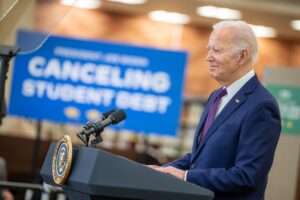Colleges still cutting offerings as pre-COVID enrollment decline continues
Colleges and universities have announced more cuts to programs and majors, continuing a trend that pre-dated COVID-19 and shows no signs of stopping.
The Associated Press reports a new wave of…

Colleges and universities have announced more cuts to programs and majors, continuing a trend that pre-dated COVID-19 and shows no signs of stopping.
The Associated Press reports a new wave of higher education cuts in recent months, as federal COVID-19 relief for colleges runs out, enrollment has continued to decline and problems with the Free Application for Federal Student Aid (FAFSA) system has been plagued with delays.
“This year going into next fall, it’s going to be bad. I think a lot of colleges are really concerned they’re not going to make their enrollment targets,” Katharine Meyer, a fellow in the Governance Studies program for the Brown Center on Education Policy at the nonprofit Brookings Institution told the AP.
In June alone, 12 small universities announced cuts, said Inside Higher Ed, after what it termed a May that included “among the deepest [cuts] reported so far this year.”
The Lion has reported on cuts at Miami University of Ohio and West Virginia University in department and majors, including women, gender and sexuality studies and race and ethnic studies. But the cuts being reported now are deeper and affect a wider range of departments and schools.
Higher Ed Drive called it restructuring by “a thousand cuts.”
In March, Bryan Alexander, a senior scholar at Georgetown University, detailed reductions in over 20 college programs, which included cuts to staffing, the elimination of departments and majors, and the shuttering of schools.
Affected colleges include Marietta College, University of New Hampshire, Concordia University, University of Nebraska, University of Arizona, University of North Carolina, University of Toledo and Penn State.
At the University of North Carolina, the school cut 20 academic programs, including traditional programs such as BA, Anthropology; BS and BA, Physics; BS, Physical Education, Teacher Education (K-12); Chinese minor; Russian major; Graduate Programs; Post-Baccalaureate Certificate in Nursing; MA, Applied Geography; MA, Mathematics; MEd, Special Education; PhD, Computational Mathematics.
Alexander blamed the cuts on a range of forces arrayed against higher education, including “demographic transition to shifting political and cultural views of academia.”
Moreover, experts are saying universities and colleges should prepare for further cuts. That’s because even if the government gets the FAFSA system back on track soon, people just don’t value a college education like they used to, say reports.
Since 2011, college and university enrollment has dropped 1.5% annually, according to figures supplied by the National Center for Education Statistics (NCES). A March report by the Gates Foundation found graduating high schoolers are skeptical of colleges’ usefulness.
The report concluded “that institutions need to prove their value to them.”
“At the end of the day, higher education has a lot of work to do to convince these audiences of its value,” says Terrell Dunn, a consultant involved in the study.
The report determined a college degree still offers all the value that it used to, but that trust by students in a college degree has declined.
That could be in part because of the constant drumbeat from the Biden administration about the high cost of debt to finance a college degree and the urgent need to forgive all student loans immediately without debate.
“The biggest concerns that seem to be holding potential students back include the fear of taking on debt, a general lack of interest in schooling, insufficient return on investment, overall stress levels and an uncertainty about the future,” said Inside Higher Ed about the Gates Foundation findings.
Alan Collinge of Student Loan Justice – a grassroots organization “dedicated to informing the public about the predatory underpinnings of both federal and private student loans in the U.S.” – tells The Lion:
“Student loan borrowing exploded during the Obama presidency, to a record $115 billion/year on his watch – far more, even, than is being borrowed today. Over 8 years in office, nearly $1 Trillion was added to the nation’s student loan balance. The Administration could not shovel money to the colleges fast enough on his watch. This allowed them to expand their campuses unchecked, create new degree programs, and keep the students enrolled longer and longer.”



